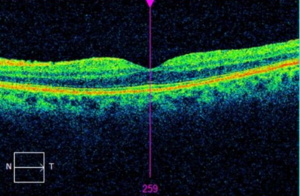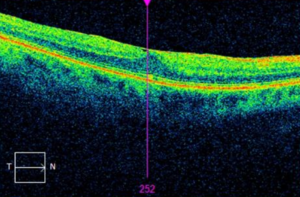Clinical trials are designed to test the safety and efficacy of new approaches to preventing, detecting, and treating disease. Clinical trials also look for new ways to use existing treatments, new drugs, surgical procedures and devices.
Participants in clinical trials with Macula Retina Vitreous Research Institute may sign up for screening to check if they are a candidate to receive the newest treatment for their vitreoretinal conditions. Patients involved in clinical research can benefit from additional care and attention from research staff, and will also help researchers find better treatments for future patients.
Active Enrolling Trials
Wet Age-Related Macular Degeneration (wAMD)
Genentech | Belvedere
A clinical trial to evaluate maintenance of vision after switching to treatment with an eye implant containing ranibizumab in participants with neovascular age‑related macular degeneration.
SOL | Ocular Therapeutix
A Phase 3, Multicenter, Double-Masked, Randomized, Parallel-Group Study to Evaluate the Efficacy and Safety of Intravitreal OTX-TKI (Axitinib Implant) in Subjects With Neovascular Age-Related Macular Degeneration (nAMD).
ASCENT | AbbVie
A Randomized, Partially Masked, Controlled, Phase 3 Clinical Study to Evaluate the Efficacy and Safety of RGX-314 Gene Therapy in Participants With nAMD.
Protocol AO | NCT05904028

Home OCT-Guided Treatment versus Treat and Extend for the Management of Neovascular AMD.
Neovascular or “wet” AMD is an ocular disease characterized by the formation of abnormal blood vessel growth that can damage the structural integrity of the macula, a region of the retina responsible for central vision. The goal of this study is to compare outcomes from two different management approaches for neovascular AMD. We will collect information on both approaches to help doctors determine which management approach works best.
If you take part in the study, you will be placed into one of the following two treatment groups: 1) Anti-VEGF injections based on Treat and Extend monitoring (standard of care treatment) approach, 2) Anti-VEGF injections based on Home OCT-guided monitoring approach.
These groups are referred to as ‘Treat and Extend’ and ‘Home OCT’ respectively. You will know which treatment you are receiving. If you are in the Home OCT group, you will be asked to take daily scans of your eyes using the Home OCT device for two years.
Diabetic Macular Edema (DME)
Protocol AN | NCT05727891

A Phase 2 Evaluation of Tonabersat for Diabetic Macular Edema (DME).
This study is being done to determine if tonabersat, a pill taken by mouth, can help reduce retinal swelling in patients with diabetic macular edema (DME). To evaluate this, participants will be randomized to take either tonabersat or placebo for 6 months.
DME is a manifestation of diabetic retinopathy and the leading cause of moderate vision loss in patients with diabetes. Without intervention, one third of eyes with center-involved DME experienced “moderate visual loss” (defined as a 15 or more letter score decrease in visual acuity) over a three-year period.
While intravitreal anti-VEGF agents have long been the mainstay of care for DME, this treatment is not without its disadvantages including the need for frequent injections, as well as the risk of complications. Thus, there is an ongoing need to identify novel therapies that are both effective for DME treatment and can reduce risks associated with treatment.
Macular Pucker
Protocol AM | NCT05145491


Randomized Trial Comparing Immediate vs. Deferred Surgery for Symptomatic Epiretinal Membranes (ERM)
Vitrectomy surgery to remove an epiretinal membrane (ERM) is one of the most common procedures performed by retinal specialists. Patients who present with significant macular changes on optical coherence tomography (OCT) but relatively good vision are often advised to defer surgery until vision declines to 20/40 or worse. However, it is unknown if delaying surgery results in worse visual acuity outcomes compared to immediate surgery. In addition, there is a need to better understand predictors of outcomes when surgery is performed and predictors of progression when surgery is deferred. Finally, one of the most common presenting symptoms attributed to an ERM is distortion of the vision. There are several objective measures of this distortion, but none have been evaluated in a randomized clinical trial, and their usefulness is unknown.
The purpose of this study is to better understand the optimal timing of surgery, to identify predictors of outcomes in those who undergo immediate surgery, to identify predictors of progression in those whose are observed, and to better characterize and evaluate the usefulness of metamorphopsia and reading speed measures.
Upcoming Trials
Wet AMD - Pivotal 2 Study of RGX-314 Gene Therapy in Participants With nAMD | ASCENT | NCT05407636
Dry AMD - Drusolv Therapeutics | OcuStatin
Geographic Atrophy - R3918-AMD-2326 and R3918-AMD-2327
Retinal Vein Occlusion - Regeneron | Quantum
Active Trials (Closed to enrollment)
Wet AMD - Study of OPT-302 in Combination with Ranibizumab (ShORe) Phase 3 Trial | OPT-302-1004 | Opthea

We are pleased to announce our involvement in a Phase 3 clinical research study offered to select participants with neovascular age-related macular degeneration (AMD). Neovascular or “wet” AMD is an ocular disease characterized by the formation of abnormal blood vessel growth that can damage the structural integrity of the macula, a region of the retina responsible for central vision. The main purpose of this study is to assess the efficacy and safety of an investigational medicine known as OPT-302 when used in conjunction with an FDA-approved medication known as ranibizumab. These medications, known as Anti-VEGF therapy, inhibit the proteins responsible for the development of new abnormal vessel growth and subsequent leakage typically found in Wet AMD.
Dry AMD - A decentralized epidemiological study of the progression of Age-related Macular Degeneration (AMD) | Character Bio
AMD has a large genetic component; 34 common genetic variants have been discovered that are associated with AMD. A weighted polygenic risk score can classify an individuals’ total level of genetic risk, and have some power to predict disease progression, in combination with environmental and clinical risk factors. Individuals with high genetic risk but don’t progress to advanced disease may have protective genetic variants. This is an epidemiologic study. There are no risks in participating in this study, as there is no administration of new medications.

